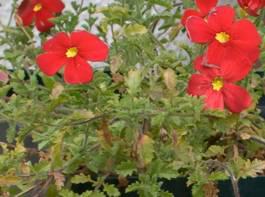Jamesbrittenia bergae
Jamesbrittenia bergae P.Lemmer
Family: Scrophulariaceae
Common names: crimson phlox
Introduction
This fairly unknown unique, crimson-flowered, herbaceous perennial from the foxglove family rivals many pelargoniums for its intense luminous colour and makes an excellent garden subject both in a pot and in the ground.

Description
Description
Jamesbrittenia bergae has a semi-upright mounding herbaceous habit that spreads as wide as it does high, ultimately to about 40-50cm. It has small, glandular, slightly lobed leaves up to 15 mm long and 5 mm wide. It branches readily to produce a fairly dense bush. The flowers are up to 30 mm wide with a narrow throat (corolla tube) about 15mm long. The filaments are fused to the inside of the corolla tube. Neither the anthers nor the stigma protrude beyond the opening of the corolla tube. The flower colour is an intense crimson red and is unique in the genus Jamesbrittenia in that it has a luminous quality, only seldom seen in the plant world in genera like Pelargonium. This makes this species highly ornamental. The throat is yellow. The fruit is a capsule 5-10 mm long that splits into two chambers releasing tiny black seeds the size of sand grains.

Jamesbrittenia bergae is a fairly fast-growing perennial and will survive quite happily for two to three years. Eventually old age will take its toll as is the case with many of the perennial Jamesbrittenia species.
Conservation Status
Status
Jamesbrittenia bergae is threatened in the wild and is listed as Vulnerable.
Distribution and habitat
Distribution description
Jamesbrittenia bergae has a very restricted distribution and is presently only known from the area around Thabazimbi in the Limpopo Province, and its habitat is threatened by agriculture. It grows naturally in fairly open exposed vegetation in heavy iron-rich soils.
Derivation of name and historical aspects
History
Despite the very striking appearance of this plant, it was only discovered in the mid-1990s by Attie Berga, and was subsequently named after him.
The genus Jamesbrittenia consists of about 83 species, native from Africa through to the Indian subcontinent, with 74 species occurring in southern Africa.
Ecology
Ecology
Not a lot is known about the ecological adaptations of Jamesbrittenia bergae in the wild. It is suspected that it mimics the parasitic plant Striga elegans in its almost identical flower shape and colour. Striga elegans is commonly found in grasslands of the summer rainfall parts of South Africa.
Uses
Use
There are no known cultural uses of this plant.
Growing Jamesbrittenia bergae
Grow
Jamesbrittenia bergae is perhaps one of the most spectacular ornamental herbaceous plants to have been discovered in recent years. It is very easy and rewarding to grow. Plants grow in almost any soil but heavier loamy soils are preferred. They grow and flower most vigorously during the summer months where they require regular watering to keep them looking good. They can be grown easily as pot plants and make spectacular hanging baskets. They also make excellent bedding plants where they enjoy a full sun or partial day shade position. Young plants are best planted in spring as temperatures start to rise. They will grow vigorously through the summer months and slow down dramatically in autumn and winter. Plants should be pruned back fairly hard in late winter/early spring as new buds and shoots appear. Jamesbrittenia bergae is not frost-hardy.

Propagation is easy both from cuttings and seed. Seed, however, is seldom produced as plants are self-infertile and therefore two genetically different plants have to be present for pollination to take place. The fine seed should be mixed well with a small quantity of fine sand and then sprinkled over a seed tray filled with a suitable well-drained seedling germination medium in spring or early summer. Cover the seeds with a very thin layer of pure river sand or vermiculite to keep them moist. Water regularly and never let the soil dry out. Germination should take place within a few weeks and will be aided by bottom heat.
Cuttings are by far the easiest means of propagation. Soft and semi-hardwood tip and heel cuttings can be taken preferably in spring or summer. Dip the cut end of the cutting in a suitable rooting hormone and place in a well-drained rooting medium like 50/50 bark/perlite or even pure riversand will do. Keep the cuttings moist and humid by placing a clear plastic covering over the pot and keep in a fairly shady cool place. Rooting takes place within 3-4 weeks. Young plants can be pricked out and potted up in a rich soil medium and grown on.
Jamesbittenia bergae fortunately is not terribly prone to pests and diseases but mealy bug, red spider mite, white fly and aphids are always a potential problem. Most insects can be treated with organic non-toxic pest repellents available at your nearest garden centre. Fungal root infections are sometimes a problem and plants are occasionally known to curl up and die spontaneously. This can be prevented with suitable fungicides.
References
- Lemmer, P. 2003. Jamesbrittenia bergae (Scrophulariaceae), a distinctive new species from Limpopo, South Africa. Bothalia 33, 2: 141-144.
- Biodiversity explorer Website. Iziko Museum. http://www.biodiversityexplorer.org/plants/scrophulariaceae/jamesbrittenia.htm
Credits
Adam Harrower
Kirstenbosch National Botanical Garden
February 2010
Plant Attributes:
Plant Type: Perennial
SA Distribution: Limpopo
Soil type: Sandy, Clay, Loam, Metal-rich
Flowering season:
PH:
Flower colour: Red
Aspect: Full Sun, Morning Sun (Semi Shade), Afternoon Sun (Semi Shade)
Gardening skill: Easy
Special Features:
Horticultural zones









Rate this article
Article well written and informative
Rate this plant
Is this an interesting plant?
Login to add your Comment
Back to topNot registered yet? Click here to register.